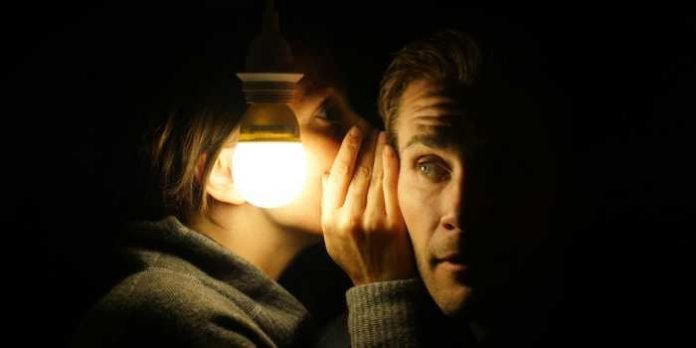There is not a bad seat in the house for Three Stories Up, the film noir-inspired murder mystery from Vancouver’s Alley Theatre and Level-Headed Friends.
Mack Gordon’s Three Stories Up tells the story of a transit cop out to solve the murder of her husband. She is also out for revenge. In true film noir style, Gordon not only provides the dialogue for his characters to speak, but gives them the ability to speak their inner thoughts, while describing the scene around them. That combination is so beautifully rendered at times that the pictures Gordon paints are so vivid, they take on a life of their own. Good thing, since the entire show is performed in a pitch black theatre.
Blindfolded and very carefully escorted to our seats inside the venue, we sit patiently, instructed not to remove our blindfolds until told to do so. Snippets of audience conversation can be heard, until an unseen voice gives us our safety briefing, and finally invites us to remove our blindfolds. The room is pitch black, save the faint glow of an emergency exit light behind us. Mood music swells and for the next 80 minutes we are transported to a contemporary Vancouver, by way of a mid-century film noir sensibility. All in the dark.
Unseen actors move about the room, inhabiting the various locations in Gordon’s story. From the scene of the murder, to the confessional of the Catholic cathedral, Gordon’s descriptions of these locales are at time excruciatingly detailed. It is not difficult to imagine how these same scenes might be staged in a more conventional production. Whether ironically, or by design, many of the conjured images of a traditional theatrical treatment include a heavy dose of low-level lighting, often shrouded in a haze of theatrical fog.
In writing about Three Stories Up, we have been asked not to reveal the identity of the actors. Cast during a blind audition process, the producers are hoping to keep this a secret for as long as possible. Their thinking is that it will allow the audience to “imagine what the characters look like without knowing who the actors are performing them”. For the most part it works, and even though some may recognize a voice, like I did opening night, it did nothing to detract from the images created in my mind’s eye.
Suffice to say each actor captures Gordon’s words with clarity, an imperative for a show that relies exclusively on words and sounds. This is no easy feat, given many of the characters explain the action, describe location, and then just as easily move into dialogue.
“I put my cigarette out on the door. No smoking inside. The patrons are all burgundy lipstick or greased side-part. The stairs leading down are dark uncarpeted red linoleum. My hair is wet and my mind is swimming. And then we collide.” – Three Stories Up: Scene IIi
As murder mysteries go, Three Stories Up, has the requisite twists and red herrings. Those looking to solve the murder mystery in real-time with the hero though, may be disappointed. Its solution felt like one of those Agatha Christie explanations where missing pieces as to motive are only revealed in the final moments.
Under Marisa Emma Smith’s direction the show takes on an almost stereophonic feel as the actors and sound effects move about the room (take a few moments once the lights come up to see just how it is all done in the dark).
It is in the stereophonic nature of this production that underscores the radio play quality of Three Stories Up. It begs the question whether performing it in the dark in a theatrical setting is a worthwhile endeavour. The answer is yes and no.
Putting aside the practical fact radio plays are no longer being produced, Three Stories Up is somewhat successful if you view the live theatre experience as a collective one. The problem is that collective experience rarely excludes the visual sense, where we can see our fellow audience members responding to what is happening on stage. It does, however, provide us with a small taste of what the visually impaired experience.
In his recent interview with Vancouver Presents, the playwright talks of having gone to Dark Table, the Vancouver restaurant where you dine in the pitch black, to discover what being visually deprived might be like. Gordon goes onto explain how that experience amped up his feelings of community with the people he was with. The big difference from dark restaurant to dark theatre though is in the interactive and social nature. Even without the benefit of sight, the two experiences are very different. While both could be considered social, the very nature of traditional theatre makes it passive, as we sit quietly and watch. Even in a dark restaurant there is an interactivity between diners that does not exist for the audience listening to Three Stories Up.
Gordon goes on to say the experience at Dark Table made him a better listener. That holds true for Three Stories Up, where we are forced to pay attention to every word. Without visual clues, our imaginations are an integral part to the play’s success.
Sound designer and Foley artist Julie Casselman does a singularly impressive job when you consider many of the sounds are created at different points in the room. The soundtrack is impressive. At one point the auditory is punctuated by the physical, although my theatre companion seated next to me did not experience it.
No doubt a weaker script would have collapsed under the pressures of this concept. Fortunately Gordon’s words, helped immensely by the performances, paint vivid pictures that transcend gimmick. Even as the lights come up and you find yourself staring into a pillar, you realize it has had zero impact on your enjoyment of Three Stories Up.
Three Stories Up by Mack Gordon. Directed by Marisa Emma Smith. An Alley Theatre and Level-Headed Friends production. On stage at 805 East Pender Street in Vancouver until October 31. Visit https://alleytheatre.ca for tickets and information.

